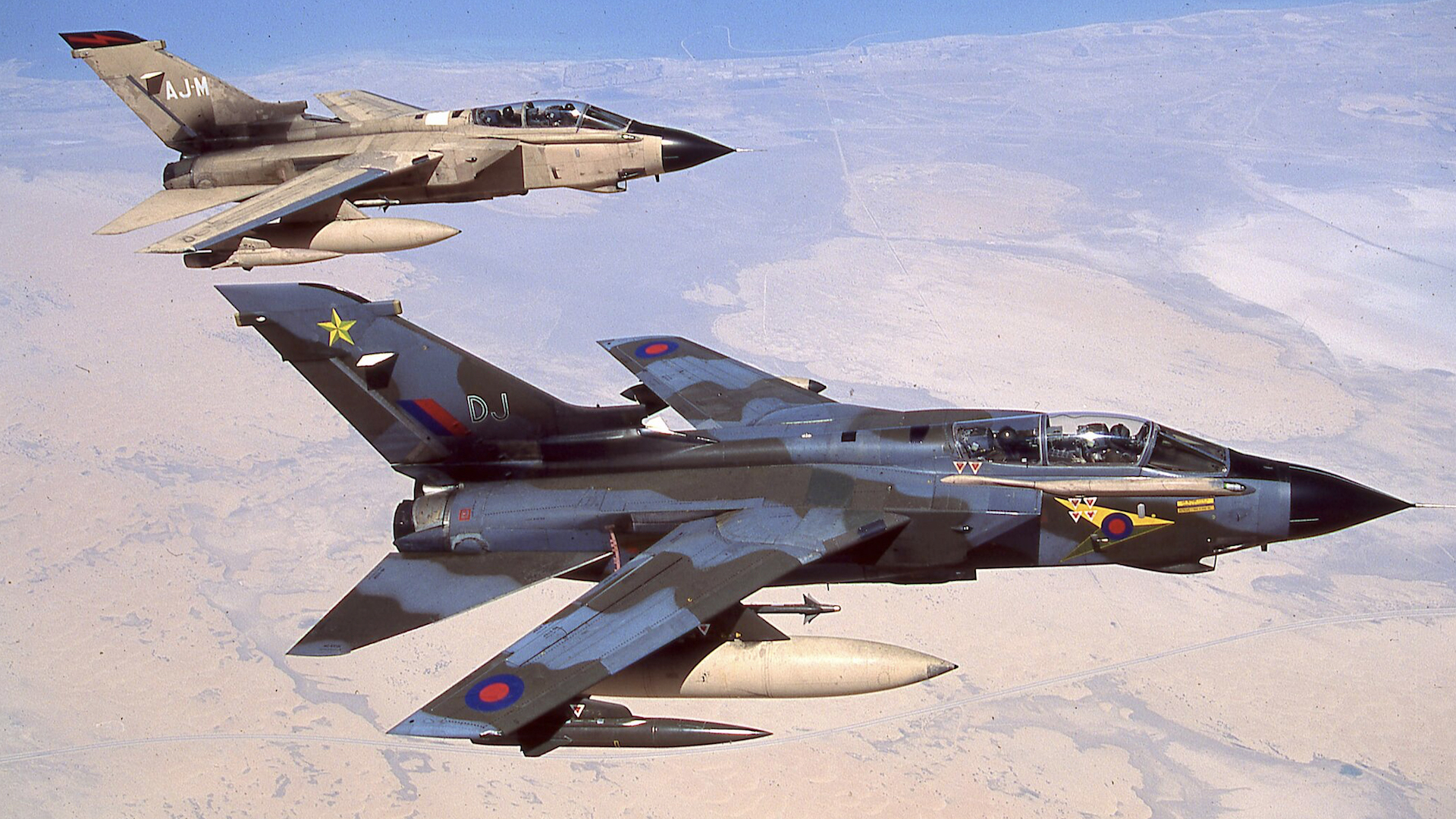Half a century ago today, the first prototype of the Panavia Tornado, aircraft P-01, was recorded taking to the skies at Manching in West Germany, with test pilots Paul Millet from British Aerospace and Nils Meister of Messerschmitt-Bölkow-Blohm (MBB) at the controls.
As you can read about here, the Tornado emerged from parallel European NATO requirements dating back to the mid-1960s and which resulted in the formation of the multinational Panavia conglomerate in 1969. Originally, this comprised the British, Dutch, Italians, and West Germans, although the Netherlands later pulled out of the program.
Developed under the Multi-Role Combat Aircraft (MRCA) program, the Tornado became a twin-engine, two-seat, swing-wing combat aircraft.

For almost 40 years, the Tornado provided the backbone of the United Kingdom’s Royal Air Force (RAF), but the British were the first to retire the aircraft, in favor of more advanced types such as the stealthy F-35 Joint Strike Fighter. Now, the Tornado is also set for retirement by Germany and Italy, both of which are also acquiring F-35s.
The swing-wing jet may survive longer with Saudi Arabia, although this operator, too, is looking at further modernizing its combat fleet, with the Dassault Rafale and the F-15EX Eagle II both in the running.
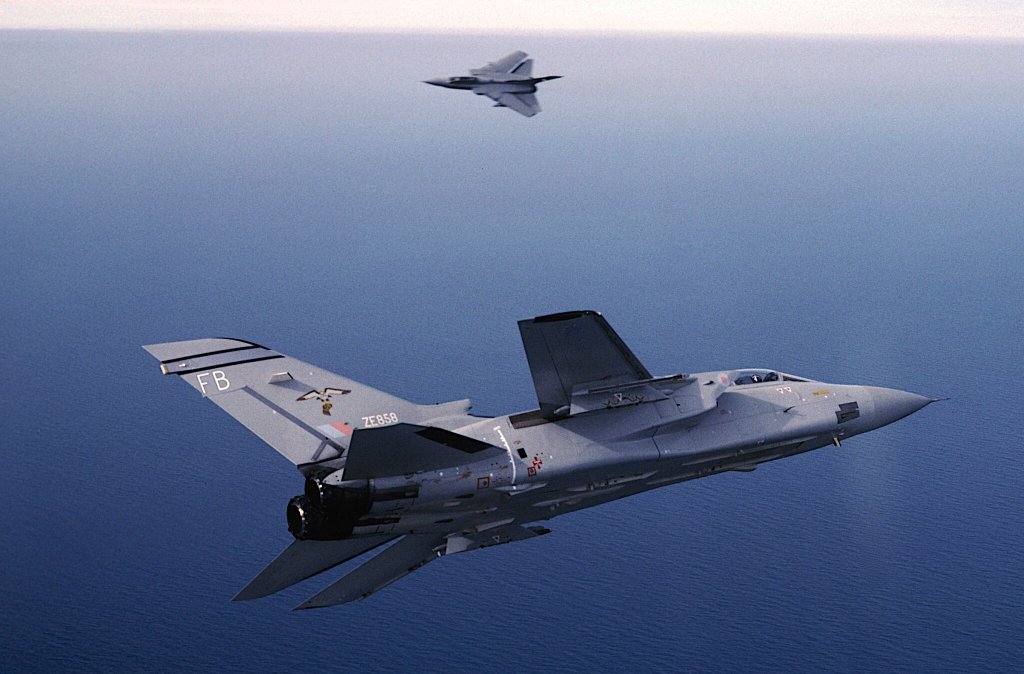
Ultimately, Panavia built Tornados in three main variants, Interdictor/Strike (IDS), Electronic Combat/Reconnaissance (ECR), and Air Defense Variant (ADV). The exploits of these main versions have been fairly well cataloged and, 50 years after the aircraft first took to the air, The War Zone looks at some of the lesser-known variants of the Tornado.
Maritime multirole with the German Navy
Today, the German Air Force, or Luftwaffe, is one of the final operators of the Tornado, alongside Italy and Saudi Arabia. Less well-known today is the fact that it was the German Navy that was the first German operator to get its hands on Tornados.
Like the Luftwaffe, the Marineflieger, or German Naval Aviation, acquired the Tornado IDS to replace the F-104 Starfighter, buying 112 in all. The first of these began to be handed over in 1982, ahead of the initial German Air Force deliveries.

Serving with two wings, the German Navy Tornado IDS was used for maritime strike and reconnaissance and, as well as the Kormoran anti-ship missile, it could be armed with the AGM-88 High-speed Anti-Radiation Missile (HARM), also used in an anti-surface warfare capacity. The German Navy Tornados pioneered the use of the HARM before the Luftwaffe started to employ it on its Tornado ECR air defense-suppression jets.
The maritime Tornados performed sterling work in the final years of the Cold War, defending the Baltic approaches and flying regular reconnaissance missions to keep track of Soviet and Warsaw Pact warships in these waters.
The last of the Marineflieger Tornados were retired in 2005 and, with them, the era of German Navy fast-jet operations came to an end.
Britain’s ship-killers
The German Navy pioneered the use of the Tornado IDS as a maritime strike aircraft, armed with Kormoran anti-ship missiles, and the Italian Air Force also did the same, until that weapon was finally withdrawn amid changing priorities after the Cold War.
The RAF, however, initially overlooked the potential of the Tornado for maritime strike, relying on the Cold War-era Buccaneer and its Sea Eagle anti-ship missiles.
It wasn’t until the end of the Cold War, and the freeing up of RAF Tornado GR1s based in Germany, that a decision was made to adapt some of these aircraft for the anti-surface warfare mission.
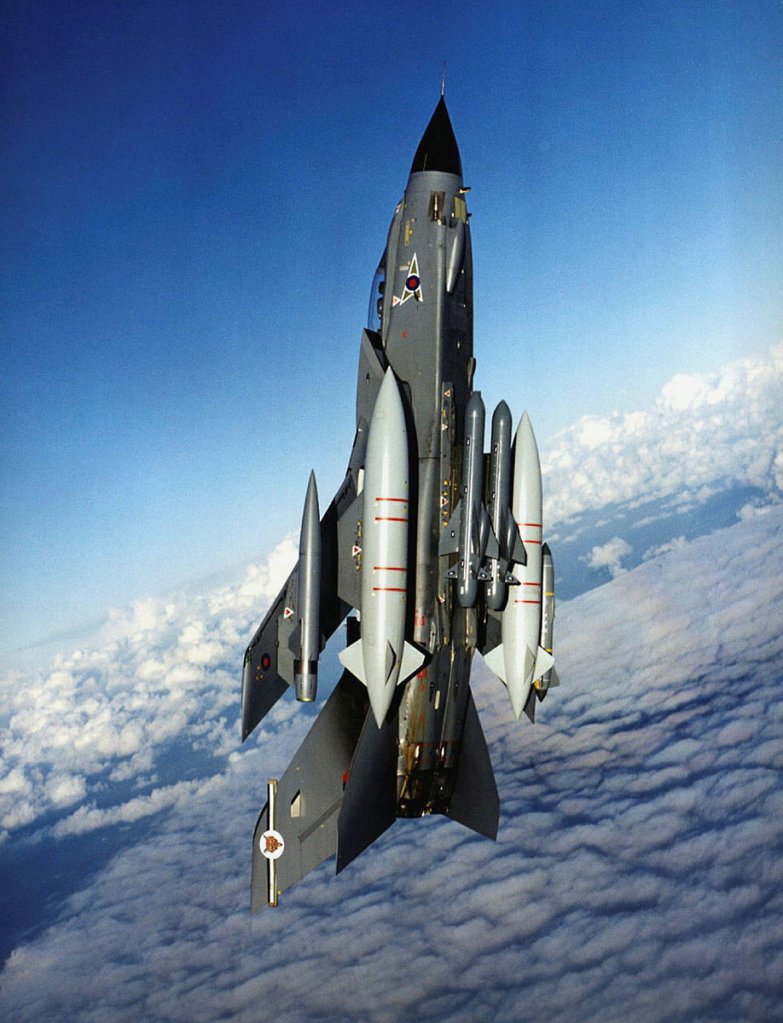
Around two-dozen Tornado GR1s, formerly based at RAF Laarbuch in Germany, were converted to Tornado GR1B standard, the first of these taking to the air in September 1993.
The Tornado GR1B was fitted with a revised stores management system and pylon adaptors for the Sea Eagle missile, two of which could be carried under the fuselage. The Sea Eagle was a ‘fire and forget’ weapon, flying toward the target using inertial guidance and then switching to an active radar seeker for the final run-in. The missile had a range of more than 50 nautical miles.
Based at RAF Lossiemouth in Scotland, two Tornado GR1B squadrons protected the United Kingdom’s northern approaches until the Sea Eagle was removed from service as a cost-saving measure in April 1999.
Tonka tankers
An often-overlooked capability on the Tornado was its provision for operating in the ‘buddy’ refueling role. In German and Italian service, the Tornado IDS was routinely fitted with a Sargent Fletcher refueling pod, carried under the fuselage, to extend the range of other Tornados (or other probe-equipped aircraft, for that matter).

The British were less enthusiastic about using the Tornado as a tactical tanker, although ahead of the 1991 Gulf War, amid concern that the conventional tanker fleet might be hard-pressed to meet demands, several RAF Tornado GR1s were modified, using Sargent Fletcher pods acquired from the German Navy. These aircraft were held in reserve at bases in Germany and the United Kingdom for possible use in the Middle East.
‘Raspberry Ripple’ testbed
A unique British variant of the jet was the Tornado GR1P, was the eighth production Tornado GR1, serial ZA326, which had been damaged in an accident on the ground in July 1980. After that, the airframe was repaired and reconfigured for test duties, wearing the distinctive blue-and-white ‘Raspberry Ripple’ scheme of the U.K.’s Royal Aircraft Establishment (RAE), an organization later subsumed into the Defense Research Agency (DRA). ZA326 was delivered to its new operator in 1983.

Among the many and varied test duties assigned to the Tornado GR1P were aerodynamic investigations of the swing wing, as well as evaluating the carriage, jettison, and release characteristics of various stores. The aircraft’s famous low-altitude capabilities were also put to the test in campaigns that examined low-level turbulence, navigation, and terrain following. Later in its career it helped develop the RAPTOR reconnaissance pod that saw valuable service with the Tornado IDS in the latter part of its RAF career, by now upgraded to GR4/GR4A standard.
Wild Weasel for the U.S. Air Force
The idea of the U.S. Air Force buying a European-designed and built combat aircraft seems almost unthinkable now, but the service actually looked at buying Tornados more than once.
The Tornado IDS was examined as a potential candidate for the Enhanced Tactical Fighter (ETF) that eventually resulted in the F-15E Strike Eagle.
At one time, there was even speculation that a U.S. order for the Tornado IDS could see the United Kingdom return the favor and buy F-15Cs to meet its own air defense requirements. That would have spelled the end of the Tornado ADV and may well have led to a very different-looking RAF today.
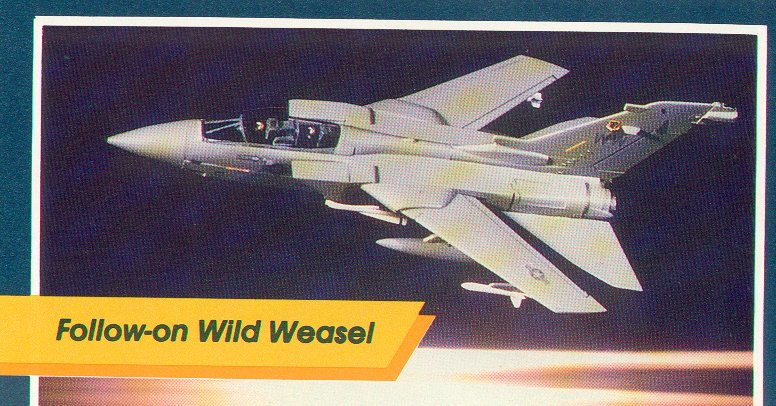
From the mid-1980s, Panavia was also eyeing the U.S. Air Force’s Follow-On Wild Weasel requirement, or FOWW that sought a replacement for the F-4G Phantom in the defense-suppression role.
Panavia teamed up with Rockwell North American Aircraft in 1988 in a bid to drum up interest in the Tornado for FOWW. In terms of systems, the Tornado FOWW would lift defense-suppression systems — and AGM-88 HARM missiles — from the Tornado ECR version, although the AGM-45 Shrike and AGM-65 Maverick would also have been added to the armory. These would be allied with the U.S.-made AN/ALQ-99 emitter locator system to pinpoint hostile air defense systems.
Even with a plan to build it at the Rockwell plant in Palmdale, the Tornado was also an outsider for FOWW. In the event, the program was canned anyway. The U.S. Air Force never got a direct replacement for the F-4G, with F-16Cs instead being modified as Wild Weasels.
J for Japan
Another potential export operator for the Tornado was identified in Japan, where the Japan Air Self-Defense Force (JASDF) was, as of the mid-1980s, looking for a successor to its Mitsubishi F-1 attack jet, which had an important maritime strike role.
In 1987, the Tornado J was proposed for the JASDF requirement, and it would have incorporated various changes to meet the operator’s specific demands. In particular, the JASDF wanted longer range than the basic Tornado IDS, to the Tornado J would have utilized the lengthened fuselage of the Tornado ADV, combined with other features from the IDS and even the Tornado ECR.
Reportedly, the third prototype Tornado ADV was modified with additional outboard underwing pylons, to demonstrate another requirement of the JASDF, although, ultimately, Japan decided to pursue the Mitsubishi F-2 to meet its needs.
Tornado 2000
Even with multiple upgrades, today’s Tornado IDS is fast headed toward retirement. The situation might have been different had the partner nations pursued plans for an advanced version, known as the Tornado 2000.
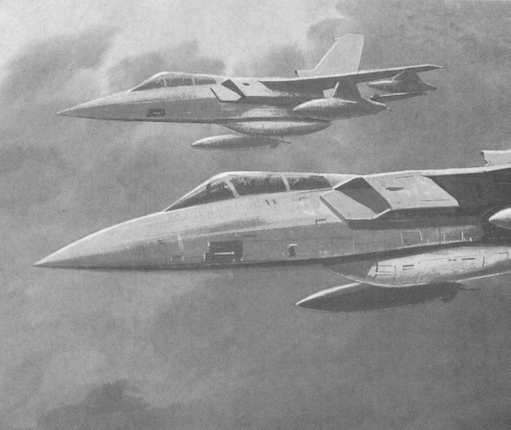
The plans for the Tornado 2000 were formulated soon after the 1991 Gulf War, in which the basic Tornado IDS flew multiple combat missions with three operators, with very successful results, but also painful losses.
Planned to enter service around the turn of the century, the Tornado 2000 would have been further optimized for low-level penetration of modern air defenses, the distinguishing features of the revised design included a lengthened fuselage housing a bigger fuel load and more avionics. To better defeat air defenses, the forward fuselage would have been subject to several radar-cross-section reduction measures, including a faceted nose and redesigned intakes. Instead of carrying additional fuel in cumbersome, radar-reflecting drop tanks, a semi-conformal fuel pack was to be fitted under the fuselage. Compared to the Tornado IDS, the new aircraft would have its radius of action increased by 25 percent.

With more advanced projects on the horizon, including the Joint Strike Fighter program, which the British would soon buy into, plans for an optimized strike/attack version of the Tornado were abandoned.
F2: The ‘Blue Circle’ fighter
Forever destined to be the butt of jokes (of which more later), the Tornado F2 nevertheless played a hugely important role in the jet’s unlikely transmogrification from low-level strike/reconnaissance aircraft to an all-weather interceptor.
Delivered in 1984-85, the 18 Tornado F2s were also intended to be interim aircraft, pending the arrival of the fully capable Tornado F3. As a result, the F2 lacked automatic wing sweep, could carry only two (not four) short-range air-to-air missiles under the wings, and used the less-powerful RB199 Mk 103 engines that were found on the Tornado IDS.

Most notoriously, most of the Tornado F2s were delivered without the Foxhunter air-intercept radar fitted, due to delays in its development. With ballast in the radome instead of a radar, references soon began to be made to ‘Blue Circle.’ As well as being a popular brand of cement, this alluded to the British practice, during the 1950s and 1960s, of assigning ‘Rainbow codes’ to defense projects, especially missiles and avionics. In fact, the ballast used in the Tornado F2 comprised steel bars, not cement.
As it was, the Tornado F2 was used for training crews, rather than operational missions, and performed a vital function until the Tornado F3 began to be delivered.
Short-lived radar-killer
One of the most intriguing episodes in the history of the Tornado’s British service is the decision to modify a batch of Tornado F3 interceptors to carry out the defense-suppression mission. Unofficially dubbed Tornado EF3, this version was armed with the same ALARM anti-radiation missiles that were provided to a portion of the U.K.’s Tornado GR1 fleet.
The Wild Weasel Tornado F3 remains a very secretive program even today but, according to accounts from those close to it, the results that could be achieved were considerably more impressive than with the ALARM-equipped Tornado GR1 or GR4.
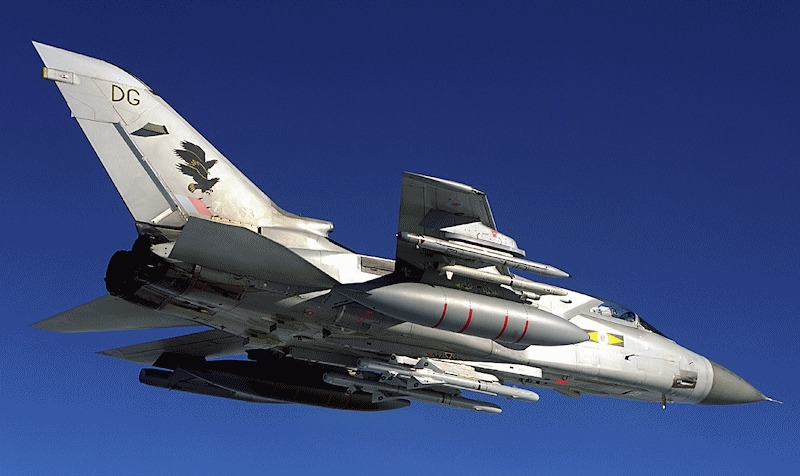
Unlike the Tornado ECR, for example, the Tornado GR1 and GR4 had a very limited ability to detect and locate enemy emitters autonomously. On the other hand, the Tornado F3 had a much more capable Radar Homing And Warning System (RHAWS), with antennas on the tailfin and mounted in the wing gloves. Once ‘tweaked,’ these provided a much more accurate emitter locator system (ELS).
The Tornado EF3 was rapidly developed and was ready to be deployed to the Middle East in 2003 for Operation Telic — the U.K. military contribution to the U.S.-led invasion of Iraq.
Bearing in mind the improved capabilities that the Tornado EF3 offered, it’s somewhat surprising that the decision was taken not to send this bespoke fleet to the Gulf and the program was ditched soon after. It remains something of a tantalizing “what might have been.”
TIARA: Crowning achievement
There are no longer Tornados flying in British skies, but a former U.K. Tornado is set to return to the air in the United States, in private hands, as you can read about here.
This is the unique Tornado F2A serial ZD902, adapted as the Tornado Integrated Avionics Research Aircraft (TIARA). This dedicated test platform was last operated by QinetiQ, the U.K.-based defense technology company that works closely with the U.K. Ministry of Defense, especially on experimental projects and novel technologies.
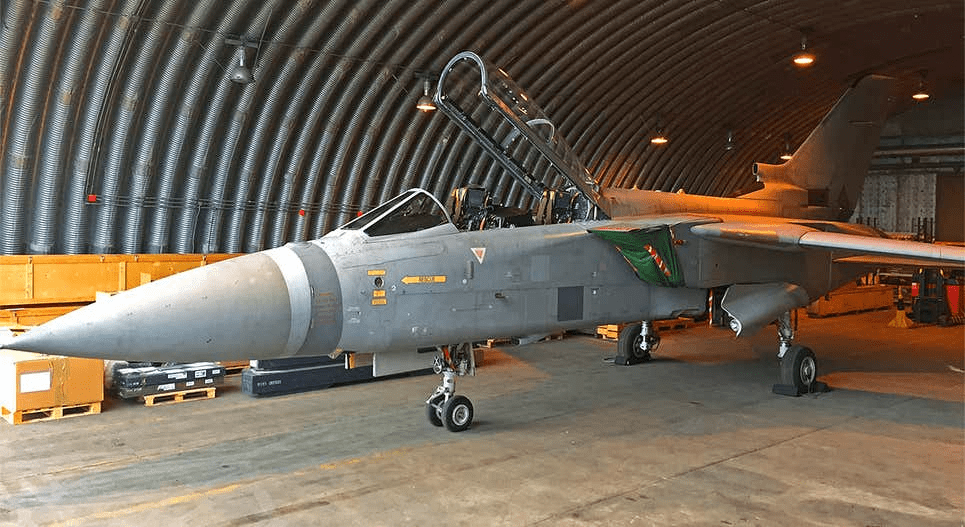
Prior to its retirement in 2011, the TIARA helped push the boundaries for various advanced air combat technologies, including infrared search and track sensors, helmet-mounted displays, sensor fusion, drone control, and others. Many of these subsequently found their way onto the Eurofighter Typhoon and the TIARA’s efforts also helped with the development of the F-35 stealth fighter.
The TIARA jet is now part of the collection of Jared Isaacman, former CEO of the red air provider Draken International, tech billionaire, astronaut, and already the operator of a MiG-29 Fulcrum personal jet that once belonged to Paul Allen. Last month, Isaacman announced plans to get the Tornado F2A back to airworthy condition in “a year.”
The most advanced private fighter in personal hands will add another fascinating chapter to the Tornado’s illustrious history.
Contact the author: thomas@thewarzone.com
